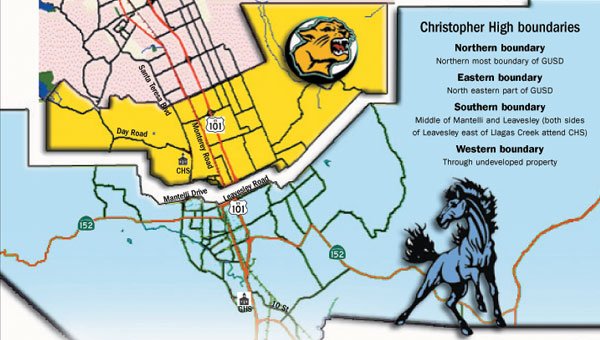High schoolers living north of Leavesley Road and Mantelli Drive
will say good-bye to their friends across the street and head north
to Christopher High School come 2009.
For a larger version of the boundary map, click on the picture at right.
High schoolers living north of Leavesley Road and Mantelli Drive will say good-bye to their friends across the street and head north to Christopher High School come 2009.
After months of closed meetings, the high school boundaries committee divulged their proposal for the line that will split Gilroy into two high school attendance zones. The committee unveiled a colored map of Gilroy with the CHS zone outlined in yellow and the Gilroy High School zone in green.
The geographically smaller CHS zone is bordered to the north by the Gilroy Unified School District northern boundary of Church Avenue in San Martin, to the east and west by undeveloped property. The major point of interest – the southern boundary – exists down the center of Leavesley and Mantelli. Students to the north will attend CHS. Students to the south, GHS.
The rows of crops on both sides of Leavesley that give way to chains of fast food restaurants, gas stations and outlets eventually turn into residential neighborhoods that will be split between two schools. The boundary runs down the middle of Leavesley, takes a quick jump north around Las Animas Park and then divides Mantelli all the way through the Country Estates development and into the hills. Many students who attended middle school together will be sent to rival schools. The delineation switches from Leavesley to Mantelli west of Church Street strictly due to capacity, consultant Juanita Contin said.
The boundary committee, which is composed of 17 parents, teachers and administrators and chaired by Superintendent Deborah Flores, presented their decision-making process and results to about 150 parents at two public forums. The presentation was available in both English and Spanish. After hearing what the public had to say, the committee will reconvene, tweak their proposal and present the final recommendation to the school board at a May 1 board meeting.
Concerned parents voiced their unease with a variety of issues, from their children’s split from longtime schoolmates to transportation to ensuring that a checks and balances system was in place with the committee’s decision.
Jodi Syth’s children currently attend Luigi Aprea Elementary School and will attend CHS when they are older. Although pleased that her children will be attending CHS, she worried about the families whose children grew up only a few blocks away that would have to make the trip down to GHS.
“A huge lump of kids in the northern district will be going to GHS,” she said. “Are they going to walk four, five miles to get to school?”
Students living on the south side of Mantelli Drive heading west out of Gilroy will be traveling nearly twice as far to get to school in the morning as CHS students.
“There are families that are a block away that will have to walk four miles,” she said. “Safety is a huge issue.”
A strong advocate for neighborhood schools, she hoped to see her children walk to school with their childhood friends.
“I walked to school,” she said. “They should be able to walk to school with their buddies.”
The school district is looking at possibly consolidating or eliminating in town bus stops for high school students and, currently, 800 students are bused to GHS, Transportation Director Darren Salo said. Transportation was a key deciding factor in drawing the boundaries, the committee said. They also aimed to strike a balance of socioeconomics and academic performance, keeping in mind that the school will only open its doors to about 500 freshmen and sophomores in 2009, all the while hoping to use a major road as the dividing line. The committee began their process by starting with neighborhoods and progressively expanding outward, committee member and GHS academic coordinator Marah Kuwada said.
Although the statistics matched up, parents expressed further concerns when it came to the issue of adjusting socially. Susan Bassi, the mother of a student who will be a GHS freshman then a CHS sophomore asked the committee to move beyond the numbers and geography and focus on using common sense. She pointed out that the high school experience of every 10th grader who will change schools after their freshman year at GHS to attend CHS in its inaugural year will be disrupted by the move. She asked the committee to consider the plight of these “guinea pig kids.”
“You’re talking about a lot of streets,” she said to the committee. “This problem always emerges and common sense seems to be abandoned. Is there going to be some compensation for parents to make the best decision for their students? As adults, we have failed this generation with poor civil engineering and bad planning on the district’s part.”
Committee member and GHS teacher Matthew Hungerford assured the parents that, although the decision to establish a transfer policy was not in the committee’s realm, a policy will exist allowing students to choose the best school for them.
The boundary could change again when a second, yet unfunded, phase of the high school is built, Contin said. The boundary was drawn on the basis that phase I will accommodate 1,100 students. Phase II will add space for an extra 700.
Denise Apuzzo, the lone board member that attended the unveiling, took the microphone and encouraged the public to submit their concerns to the board.
“I have the same concerns you do,” she said to the audience. “I want everyone to feel like they’ve had their input heard.”
Demographic comparisons
Low socioeconomic status
CHS: 44
GHS: 48
Below/far below basic on state language arts
CHS: 28
GHS: 29
Below/far below basic on state math
CHS: 35
GHS: 36
All demographics for CHS are projected














